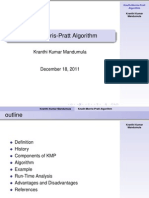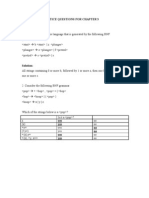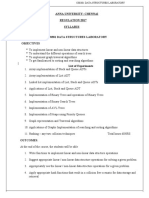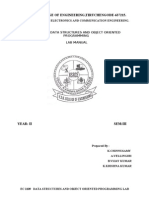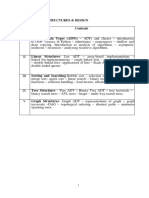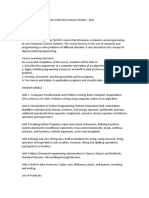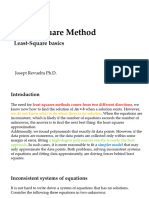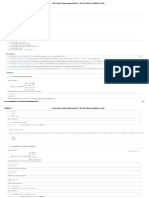0 ratings0% found this document useful (0 votes)
182 viewsSpring End Sem Data Structure Question 2012-13
The document is an exam paper for a data structures and algorithms course. It contains 12 questions covering topics like linked lists, arrays, sorting, binary trees, search trees, graphs, and recursion. Students are instructed to show their work and intermediate steps for questions involving algorithms. Figures 1 and 2 provide additional data for questions about graphs and search trees.
Uploaded by
Aditya Acharya Triple ACopyright
© © All Rights Reserved
Available Formats
Download as DOCX, PDF, TXT or read online on Scribd
0 ratings0% found this document useful (0 votes)
182 viewsSpring End Sem Data Structure Question 2012-13
The document is an exam paper for a data structures and algorithms course. It contains 12 questions covering topics like linked lists, arrays, sorting, binary trees, search trees, graphs, and recursion. Students are instructed to show their work and intermediate steps for questions involving algorithms. Figures 1 and 2 provide additional data for questions about graphs and search trees.
Uploaded by
Aditya Acharya Triple ACopyright
© © All Rights Reserved
Available Formats
Download as DOCX, PDF, TXT or read online on Scribd
You are on page 1/ 2
1
Department of Computer Science & Engineering
National Institute of Technology, Rourkela
End-Semester Examination (Spring -2012-13)
Sub: Data Structure and Algorithm (CS- 102)
Time: 3 hrs, FM: 50
Answer as many questions as possible. Mark secured above FIFTY will be converted to
FIFTY. Wherever necessary show all steps in your answer. Answer without the
intermediate steps will NOT FETCH any mark. This question paper contains TWO pages.
All questions carry equal marks.
[1] Write an algorithm to insert an ITEM into a two-way linked list sorted in increasing order. Each node
in the list contains three fields: INFO, FORW and BACKW where the pointer FORW points to the
successor and BACKW points to the predecessor of a node. Pointers HEAD points to the first node
and TAIL points to the last node in the two-way list. [5]
[2] Write an algorithm to delete an ITEM from a one-dimensional sorted array of N elements. Array is
sorted in the increasing order. Your algorithm must check for underflow condition. [5]
[3] Perform QUICKSORT on the array given below. You must show the content of the array at each step
in the sorting process. No mark will be awarded if the sorting process is not shown clearly. [5]
[4] Inorder and Postorder traversal of a binary tree is given below. Construct the corresponding binary
tree. Show each steps in the construction process. [5]
Inorder: C, D, E, B, G, H, F, K, L, P, Q, M, N, J, A
Postorder: E, D, C, H, G, Q, P, N, M, L, K, J, F, B, A
[5] Preorder traversal of an m-way search tree is defined as follows: Visit all the keys in the root node
first, followed by visiting all nodes in the subtrees beginning from left to right recursively in preorder.
Construct a 3-way search tree for the following keys: G S F L Q X Z V R A I J W. Perform preorder
traversal in the above constructed 3-way search tree as per the above definition. [2+3]
[6] Use Fibonacci search to locate the key K = 67 in the list given below. Trace each step in your search
process. [5]
11, 89, 34, 15, 90, 67, 88, 01, 36, 98, 76, 50
[7] An AVL search tree is shown in Figure -2. Delete 75 from the tree. [5]
[8] Find the shortest path from node 0 to rest of nodes in the graph using Bellman-Ford algorithm.
Adjacency matrix for the graph is shown in Figure -1. Show each step in finding the shortest path. [5]
44 33 11 55 77 90 40 60 99 22 88 66
2
[9] Find the minimum cost spanning tree for the graph, whose adjacency matrix is given in Figure -1. Use
Prims algorithm for finding the minimum cost spanning tree. [5]
[10] Construct DFS starting at node 1 for the graph whose adjacency matrix is given in Figure -1. [5]
[11] Define recursion. Write a recursive algorithm to compute the factorial of a given number N. [5]
[12] Define the following terms [1+2+2]
[a] Extended binary tree
[b] m-way search tree
[c] B tree
0 1 2 3 4 5
0 0 50 10 45
1 0 15 10
2 20 0 15
3 20 35 30
4 30 0
5
46
34 75
22 41
11
25
9
55 80
60
79
45
38
44
90
85
36 40
35
Figure -1
Figure - 2
You might also like
- Programming and Data Structures: Debasis SamantaNo ratings yetProgramming and Data Structures: Debasis Samanta63 pages
- Data Structures Part - A (Shortanswer Questions) : Vemu Institute of TechnologyNo ratings yetData Structures Part - A (Shortanswer Questions) : Vemu Institute of Technology6 pages
- Design and Analysis of Algorithm Lab (BSCS2351) Lab ManualNo ratings yetDesign and Analysis of Algorithm Lab (BSCS2351) Lab Manual46 pages
- Data Structures - Stack - and - Queue - Hands-On100% (1)Data Structures - Stack - and - Queue - Hands-On3 pages
- Lab 04 Singly Linked List: CS162 - Programming TechniquesNo ratings yetLab 04 Singly Linked List: CS162 - Programming Techniques8 pages
- Siddaganga Institute of Technology, Tumakuru - 572 103: Usn 1 S I OE02No ratings yetSiddaganga Institute of Technology, Tumakuru - 572 103: Usn 1 S I OE022 pages
- Practice Questions For Chapter 3 With AnswersNo ratings yetPractice Questions For Chapter 3 With Answers9 pages
- Practical - 7: Aim: Implement A Program That Remove Left Recursion On Given Grammar. Theory: Left RecursionNo ratings yetPractical - 7: Aim: Implement A Program That Remove Left Recursion On Given Grammar. Theory: Left Recursion4 pages
- Implementation of Queue Data Structure Using Array: 20CS2013 L-Data Structures and Algorithms LabNo ratings yetImplementation of Queue Data Structure Using Array: 20CS2013 L-Data Structures and Algorithms Lab3 pages
- CB19241-CSBS-Data Structure and Algorithms-Theory-SyllabusNo ratings yetCB19241-CSBS-Data Structure and Algorithms-Theory-Syllabus4 pages
- R. C.Technical Institute Computer Department Sola, AhmedabadNo ratings yetR. C.Technical Institute Computer Department Sola, Ahmedabad3 pages
- Visvesvaraya Technological University: Web Technology and Its Applications Practical Assessment (18Cs63)No ratings yetVisvesvaraya Technological University: Web Technology and Its Applications Practical Assessment (18Cs63)20 pages
- Oracle Financial Services Software Sample Programming Placement Paper Level1100% (1)Oracle Financial Services Software Sample Programming Placement Paper Level112 pages
- Pointers HEAD Points To The First Node and TAIL Points To The Last Node in The Double Linked List.No ratings yetPointers HEAD Points To The First Node and TAIL Points To The Last Node in The Double Linked List.2 pages
- Production Planning and Control (MEFB 433) : Ts. Zubaidi Faiesal Email: Zubaidi@uniten - Edu.my Room No. BN-1-010No ratings yetProduction Planning and Control (MEFB 433) : Ts. Zubaidi Faiesal Email: Zubaidi@uniten - Edu.my Room No. BN-1-01036 pages
- Instant download (Ebook) Quantum Systems, Channels, Information by Alexander S. Holevo ISBN 9783110642490, 3110642492 pdf all chapter100% (7)Instant download (Ebook) Quantum Systems, Channels, Information by Alexander S. Holevo ISBN 9783110642490, 3110642492 pdf all chapter67 pages
- The Mathematics of Modern Physics: DescriptionNo ratings yetThe Mathematics of Modern Physics: Description2 pages
- Protein Alignment Scoring - PAM and BLOSUMNo ratings yetProtein Alignment Scoring - PAM and BLOSUM11 pages
- Adversarial Validation Approach To Concept Drift Problem in User Targeting Automation Systems at UberNo ratings yetAdversarial Validation Approach To Concept Drift Problem in User Targeting Automation Systems at Uber6 pages
- Special Relativity - What's The Relationship Between $SL (2, - Mathbb (C) ) $, $SU (2) - Times SU (2) $ and $SO (1,3) $ - Physics Stack ExchangeNo ratings yetSpecial Relativity - What's The Relationship Between $SL (2, - Mathbb (C) ) $, $SU (2) - Times SU (2) $ and $SO (1,3) $ - Physics Stack Exchange6 pages
- Introduction To Computational Finance and Financial EconometricsNo ratings yetIntroduction To Computational Finance and Financial Econometrics54 pages
- Katsande Android Applicationfor Crop Disease Diagnosis Using Image Processing and Deep LearningNo ratings yetKatsande Android Applicationfor Crop Disease Diagnosis Using Image Processing and Deep Learning84 pages
- Mixed-Integer Linear Programming (MILP) - MATLAB Intlinprog - MathWorks FranceNo ratings yetMixed-Integer Linear Programming (MILP) - MATLAB Intlinprog - MathWorks France11 pages




